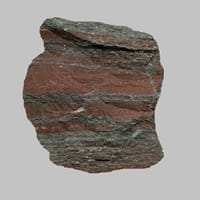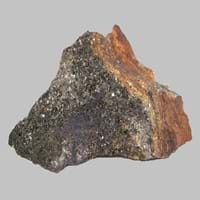Jaspillite and Hornfels
Definition
Definition
Jaspillite is an iron rich chemically formed rock which is common in banded iron formation rocks
Hornfels is a metamorphic rock formed by the contact between mudstone or other clay rich rock, and a hot igneous body, and represents a heat altered equivalent of the original rock
History
Origin
Western Australia, Minnesota
New Zealand
Discoverer
Unknown
Unknown
Etymology
From Jaspilite (Mineral), a compact siliceous rock which resembles jasper
From German which means hornstone
Class
Sedimentary Rocks
Metamorphic Rocks
Sub-Class
Durable Rock, Soft Rock
Durable Rock, Soft Rock
Family
Group
Not Applicable
Not Applicable
Other Categories
Coarse Grained Rock, Opaque Rock
Fine Grained Rock, Opaque Rock
Texture
Texture
Banded, Trellis
Granular, Platy
Color
Red, Reddish Brown
Brown, Dark Greenish - Grey, Green, Reddish Brown
Maintenance
Less
Less
Durability
Durable
Durable
Water Resistant
No
Yes
Scratch Resistant
No
No
Stain Resistant
No
No
Wind Resistant
No
No
Acid Resistant
No
No
Appearance
Banded and Glassy
Dull
Uses
Architecture
Interior Uses
Decorative Aggregates, Interior Decoration
Decorative Aggregates, Flooring, Homes, Interior Decoration
Exterior Uses
As Facing Stone, Garden Decoration, Paving Stone
As Building Stone, As Facing Stone, Garden Decoration, Office Buildings, Paving Stone
Other Architectural Uses
Curbing
Curbing
Industry
Construction Industry
As a Flux in the Production of Steel and Pig Iron, As a Sintering Agent in Steel Industry to process Iron Ore, As Dimension Stone, Cement Manufacture, for Road Aggregate, Making natural cement, Manufacture of Magnesium and Dolomite Refractories
for Road Aggregate, Roadstone
Medical Industry
Not Available
Not Available
Antiquity Uses
Artifacts, Jewellery, Monuments
Artifacts, Monuments
Other Uses
Commercial Uses
Creating Artwork, Jewelry
Cemetery Markers, Commemorative Tablets, Creating Artwork
Types
Types
Algoma-type , Lake Superior-type and Superior-type
Biotite hornfels
Features
Is one of the oldest rock
Smooth to touch
Archaeological Significance
Monuments
Used
Used
Famous Monuments
Not Available
Not Available
Sculpture
Not Yet Used
Not Yet Used
Famous Sculptures
Not Applicable
Not Applicable
Pictographs
Used
Used
Petroglyphs
Used
Used
Figurines
Not Yet Used
Not Yet Used
Fossils
Present
Absent
Formation
Formation
Jaspillite is a type of sedimentary rock which is formed by the compaction and sedimentation of pieces of broken or weathered rocks and minerals.
Due to change in environmental conditions, rocks are heated and pressurized deep inside the Earth's surface. Hornfels is formed from the extreme heat caused by magma or by the intense collisions and friction of tectonic plates.
Composition
Mineral Content
Coesite, Quartz, Sand
Andalusite
Compound Content
Fe, Iron(III) Oxide, Silicon Dioxide
Fe, Mg
Transformation
Metamorphism
No
No
Types of Metamorphism
Not Applicable
Not Applicable
Weathering
Yes
Yes
Types of Weathering
Biological Weathering, Chemical Weathering
Biological Weathering
Erosion
Yes
Yes
Types of Erosion
Chemical Erosion, Coastal Erosion
Chemical Erosion, Glacier Erosion, Sea Erosion, Water Erosion, Wind Erosion
Properties
Physical Properties
Hardness
3
2-3
Grain Size
Large and Coarse Grained
Fine Grained
Fracture
Conchoidal
Conchoidal
Streak
White
Unknown
Porosity
Very Less Porous
Highly Porous
Luster
Earthy
Shiny
Compressive Strength
230.00 N/mm2
6
5.80 N/mm2
31
Cleavage
Not Available
Perfect
Toughness
Not Available
Not Available
Specific Gravity
5.0-5.3
3.4-3.9
Transparency
Translucent to Opaque
Opaque
Density
0-5.7 g/cm3
0.25-0.30 g/cm3
Thermal Properties
Specific Heat Capacity
3.20 kJ/Kg K
1
0.84 kJ/Kg K
15
Resistance
Heat Resistant, Impact Resistant, Wear Resistant
Heat Resistant, Impact Resistant, Pressure Resistant
Reserves
Deposits in Eastern Continents
Asia
Russia
Bangladesh, Bhutan, China, India, North Korea, Qatar, Russia, Saudi Arabia, South Korea, Thailand
Africa
Not Available
Cameroon, East Africa, Tanzania, Western Africa
Europe
Ukraine
United Kingdom
Others
Not Available
Not Available
Deposits in Western Continents
North America
Canada, USA
Canada, USA
South America
Brazil
Bolivia, Brazil, Colombia, Ecuador
Deposits in Oceania Continent
Australia
Western Australia
New South Wales, New Zealand, Queensland, Western Australia
All about Jaspillite and Hornfels Properties
Know all about Jaspillite and Hornfels properties here. All properties of rocks are important as they define the type of rock and its application. Jaspillite belongs to Sedimentary Rocks while Hornfels belongs to Metamorphic Rocks.Texture of Jaspillite is Banded, Trellis whereas that of Hornfels is Granular, Platy. Jaspillite appears Banded and Glassy and Hornfels appears Dull. The luster of Jaspillite is earthy while that of Hornfels is shiny. Jaspillite is available in red, reddish brown colors whereas Hornfels is available in brown, dark greenish - grey, green, reddish brown colors. The commercial uses of Jaspillite are creating artwork, jewelry and that of Hornfels are cemetery markers, commemorative tablets, creating artwork.
|
||
|
||
|










